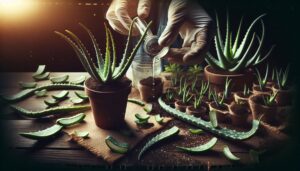Introduction:

Aloe vera, a succulent plant revered for its numerous health and skincare benefits, has earned a well-deserved spot in many households. Whether it’s to soothe sunburns, moisturize skin, or purify indoor air, aloe vera’s versatility makes it a cherished addition to any home garden. However, as with any living organism, aloe vera occasionally requires repotting or replanting to ensure optimal growth and vitality.
In this guide, we delve into the art of replanting aloe vera, offering step-by-step instructions and expert tips to help you nurture your beloved succulent back to health. From selecting the right potting mix to understanding the nuances of root division, we’ll cover everything you need to know to embark on this rejuvenating journey for your aloe plant. So, roll up your sleeves and let’s delve into the intricacies of giving your aloe vera a new lease on life.
Gathering Materials and Preparation
Before you embark on the task of replanting your aloe vera, it’s essential to gather all the necessary materials and prepare your workspace. Here’s a comprehensive list of items you’ll need:
- Aloe Vera Plant: Choose a healthy aloe vera plant that has outgrown its current pot or shows signs of root-bound growth.
- New Pot: Select a pot that is slightly larger than the current one, with drainage holes at the bottom to prevent waterlogging. Terra cotta pots are ideal as they provide good airflow to the roots.
- Potting Mix: Opt for a well-draining potting mix specifically formulated for succulents or cacti. Alternatively, you can create your own mix by combining equal parts of potting soil, perlite, and coarse sand.
- Trowel or Spoon: You’ll need a small gardening trowel or spoon to carefully remove the aloe vera plant from its current pot without damaging the roots.
- Newspaper or Paper Towels: Lay down newspaper or paper towels to catch any soil spills and make cleanup easier.
- Gloves: Aloe vera plants have spiky leaves that can cause skin irritation, so it’s advisable to wear gloves while handling them.
- Pruning Shears: If your aloe vera plant has any dead or damaged leaves, you’ll need pruning shears to trim them away before replanting.
- Watering Can: Prepare a watering can filled with room temperature water to hydrate the newly replanted aloe vera.
Once you’ve gathered all the necessary materials, it’s time to prepare your workspace. Here’s a step-by-step guide:
- Choose a Well-Lit Area: Find a well-lit area with indirect sunlight to work on replanting your aloe vera. Avoid direct sunlight, as it can stress the plant during the transplanting process.
- Cover the Work Surface: Lay down newspaper or paper towels to protect your work surface from soil and water spills.
- Prepare the New Pot: Fill the bottom of the new pot with a layer of potting mix, ensuring that the drainage holes are not blocked. The layer should be deep enough to accommodate the aloe vera’s roots.
- Loosen the Soil: Gently loosen the soil around the base of the aloe vera plant in its current pot using a trowel or spoon. This will make it easier to remove the plant without damaging the roots.
- Carefully Remove the Plant: Support the base of the aloe vera plant with one hand and tilt the pot sideways with the other hand. Slowly slide the plant out of the pot, taking care not to tug or pull forcefully, as this can damage the roots.
- Inspect the Roots: Examine the roots of the aloe vera plant for any signs of rot or overcrowding. Trim away any dead or mushy roots using pruning shears, and gently tease apart any tangled roots to encourage outward growth.
Transplanting the Aloe Vera

Now that you’ve gathered your materials and prepared your workspace, it’s time to delve into the process of transplanting your aloe vera into its new pot. Follow these step-by-step instructions to ensure a smooth and successful replanting:
- Centering the Plant: Place the aloe vera plant in the center of the new pot, ensuring that the base of the plant sits just below the rim of the pot. Adjust the positioning if necessary to achieve a balanced appearance.
- Adding Potting Mix: Begin filling the pot with potting mix around the base of the aloe vera plant. Gently pat down the soil as you go to eliminate any air pockets and provide stability for the plant.
- Layering the Soil: Continue adding potting mix until the roots of the aloe vera plant are covered and the soil level reaches about an inch below the rim of the pot. Avoid burying the plant too deeply, as this can lead to rotting of the stem.
- Firming the Soil: Use your fingers to lightly press down on the soil around the base of the plant to secure it in place. Ensure that the plant stands upright and is well-supported by the surrounding soil.
- Watering the Plant: Once the aloe vera plant is securely replanted, water it thoroughly until excess water drains out from the bottom of the pot. Allow the soil to dry out slightly between watering sessions to prevent overwatering, which can cause root rot.
- Placement and Sunlight: Find a suitable location for your newly transplanted aloe vera plant, preferably near a window with indirect sunlight. Avoid placing the plant in direct sunlight immediately after replanting, as this can stress the plant. Gradually introduce it to more sunlight over the course of a few days.
- Monitoring and Care: Keep a close eye on your aloe vera plant in the days following replanting, ensuring that the soil remains lightly moist but not waterlogged. Resume your regular watering schedule once the plant shows signs of new growth, indicating that it has successfully acclimated to its new environment.
To help you keep track of the replanting process, refer to the table below summarizing the key steps:
|
Step |
Description |
|
1. Centering the Plant |
Position the aloe vera plant in the center of the pot |
|
2. Adding Potting Mix |
Fill the pot with potting mix around the plant |
|
3. Layering the Soil |
Continue adding soil until roots are covered |
|
4. Firming the Soil |
Press down lightly to secure the plant |
|
5. Watering the Plant |
Water thoroughly and allow excess to drain |
|
6. Placement and Sunlight |
Choose a suitable location with indirect sunlight |
|
7. Monitoring and Care |
Keep an eye on the plant and adjust watering as needed |
Post-Replanting Care and Maintenance
Congratulations on successfully replanting your aloe vera! Now that your plant has settled into its new home, it’s essential to provide it with the care and attention it needs to thrive. Here’s a guide to post-replanting care and maintenance to ensure the continued health and vitality of your aloe vera:
- Watering Schedule: Aloe vera plants are drought-tolerant succulents, meaning they prefer infrequent but thorough watering. Allow the soil to dry out completely between waterings, and then water the plant deeply until excess water drains out from the bottom of the pot. During the growing season (spring and summer), water your aloe vera approximately once every two to three weeks. In the dormant season (fall and winter), reduce watering frequency to once a month or less, as the plant’s growth slows down.
- Light Requirements: Adequate sunlight is crucial for the health of your aloe vera plant. Place it in a location where it can receive bright, indirect sunlight for several hours a day. Avoid placing the plant in direct sunlight for extended periods, as this can lead to sunburn and stress.
- Temperature and Humidity: Aloe vera plants thrive in warm temperatures ranging from 60°F to 80°F (15°C to 27°C). Keep the plant away from drafts or cold windows during the winter months, as exposure to cold temperatures can damage the foliage. Aloe vera plants prefer low to moderate humidity levels, making them well-suited for indoor environments.
- Fertilization: Aloe vera plants are light feeders and do not require frequent fertilization. Apply a balanced, water-soluble fertilizer diluted to half strength every four to six weeks during the growing season to provide essential nutrients. Avoid over-fertilizing, as this can lead to fertilizer burn and damage the roots.
- Pruning and Maintenance: Regular pruning helps keep your aloe vera plant healthy and attractive. Remove any dead or yellowing leaves using sterilized pruning shears to prevent the spread of disease. You can also trim off offsets (baby aloe plants) that emerge from the base of the mother plant and replant them to propagate new plants.
- Pest and Disease Control: Aloe vera plants are relatively resistant to pests and diseases, but they can occasionally attract mealybugs, aphids, or fungal infections. Inspect your plant regularly for signs of pest infestation or disease, such as yellowing leaves or white powdery residue. Treat any issues promptly using natural remedies or insecticidal soap to prevent them from spreading to other plants.
To help you maintain your aloe vera plant’s health and vigor, refer to the table below summarizing post-replanting care and maintenance tips:
|
Care Aspect |
Description |
|
Watering Schedule |
Water deeply and infrequently, allowing soil to dry between waterings |
|
Light Requirements |
Place in bright, indirect sunlight for several hours daily |
|
Temperature & Humidity |
Maintain warm temperatures and moderate humidity levels |
|
Fertilization |
Apply diluted, balanced fertilizer every 4-6 weeks during growing season |
|
Pruning and Maintenance |
Remove dead or yellowing leaves, prune offsets as needed |
|
Pest and Disease Control |
Inspect regularly for pests and diseases, treat promptly if detected |
Propagation Techniques

for Aloe Vera
Propagating aloe vera is an excellent way to expand your collection of these versatile succulents or share them with friends and family. There are several methods of aloe vera propagation, each with its advantages and considerations. Here, we’ll explore three common techniques: offsets, leaf cuttings, and division.
- Offsets (Pups):
- Offsets, also known as pups or babies, are miniature versions of the parent plant that grow from the base of the main stem.
- To propagate using offsets, wait until they are a few inches tall and have developed their own root system. Carefully remove the offset from the parent plant using a clean, sharp knife or scissors.
- Plant the offset in a small pot filled with well-draining potting mix, burying the base of the offset slightly below the soil surface. Water lightly and place the pot in a warm, bright location with indirect sunlight.
- Within a few weeks, the offset will establish roots and begin to grow into a new aloe vera plant.
- Leaf Cuttings:
- Leaf cuttings involve harvesting individual leaves from the parent plant and allowing them to root and grow into new plants.
- Choose healthy, mature leaves from the outermost rows of the aloe vera plant. Use a clean, sharp knife to cut the leaves close to the base of the plant.
- Allow the leaf cuttings to air dry for a day or two to form a callus on the cut end, which helps prevent rotting when planted.
- Plant the leaf cuttings in a shallow tray or pot filled with well-draining soil mix, burying the cut end slightly below the soil surface. Water lightly and place the tray in a warm, bright location with indirect sunlight.
- Roots will begin to emerge from the base of the leaf cutting, and a new plant will develop over time.
- Division:
- Division involves separating mature aloe vera plants into smaller sections, each with its own root system.
- To divide an aloe vera plant, carefully remove it from its pot and gently tease apart the root ball into smaller sections using your hands or a clean, sharp knife.
- Plant each divided section in its own pot filled with well-draining potting mix, ensuring that the roots are spread out and covered with soil. Water lightly and place the pots in a warm, bright location with indirect sunlight.
- With proper care, each divided section will establish roots and grow into a new aloe vera plant.
Refer to the table below for a summary of the propagation techniques for aloe vera:
|
Propagation Technique |
Description |
|
Offsets (Pups) |
Harvest miniature plants growing from the base of the parent plant |
|
Leaf Cuttings |
Harvest individual leaves and allow them to root and grow into new plants |
|
Division |
Separate mature plants into smaller sections, each with its own root system |
Conclusion: Nurturing Your Aloe Vera Garden

As we conclude our journey into the world of aloe vera cultivation and care, it’s evident that these remarkable succulents offer not only aesthetic appeal but also a plethora of practical benefits. From soothing sunburns to purifying indoor air, aloe vera plants have earned their place as cherished companions in homes worldwide.
Through the process of replanting, we’ve explored the delicate art of giving our aloe vera plants a fresh start, ensuring their continued growth and vitality. From gathering materials and preparing the workspace to mastering the techniques of transplantation and post-replanting care, we’ve equipped ourselves with the knowledge and skills needed to foster healthy and thriving aloe vera gardens.
Moreover, delving into propagation techniques has opened up exciting possibilities for expanding our aloe vera collections and sharing the joy of gardening with others. Whether through offsets, leaf cuttings, or division, the journey of propagating aloe vera plants promises new beginnings and boundless potential.
As stewards of these resilient succulents, let us embrace the responsibility of providing them with the care and attention they deserve. Through mindful watering, proper lighting, and vigilant pest management, we can ensure that our aloe vera gardens flourish for years to come, enriching our lives with their beauty and benefits.
So, as you tend to your aloe vera garden, may you find joy in the nurturing process and satisfaction in the flourishing growth of these remarkable plants. With each new leaf and each tender shoot, may your connection to nature deepen, reminding you of the profound resilience and beauty inherent in the world around us.
Thanks for allowing us to share with you. Visit us at The Landscape Connection if you happen to be in the area.
For more valuable Expert Tips check out our comprehensive Houseplant Guide to Tips for Indoor Plant Care.





Pingback: Aloe Vera, The Healing Succulent That Thrives Indoors with Minimal Care